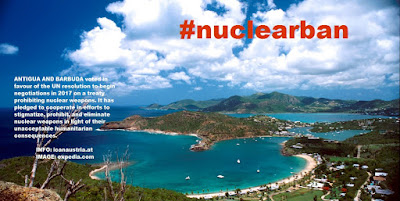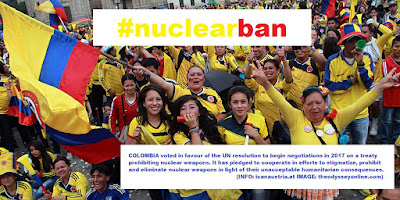March 13, 2017, is "Commonwealth Day" - "the annual celebration of the Commonwealth of Nations held on the second Monday in March, and marked by a multi-faith service in Westminster Abbey, normally attended by Queen Elizabeth II as Head of the Commonwealth . . . . ".
The Commonwealth of Nations includes these countries:
 |
| Commonwealth Countries |
This year, the theme of Commonwealth Day is "A Peace-building Commonwealth."
So what I can't figure out is how certain prominent Commonwealth countries voted "no" to the UN negotiations on a global nuclear weapons ban, when it was approved this past October:
 |
| Vote on resolution to negotiate a ban on nuclear weapons in 2017 (L-41) Green - Yes (123, 76%) Red - No (38, 24%) Beige - Abstained (Via @ILPIwmd - share on Twitter) |
Make no mistake -- the majority of the countries of the world approved the resolution to move forward with nuclear ban negotiations . . . the preparatory meetings have already taken place . . . and the first formal sessions will begin at the end of March.
And let's be clear: so many Commonwealth countries were actually sponsors of the resolution that you could practically call it a Commonwealth project:
Bahamas
Belize
Fiji
Grenada
Jamaica
Kenya
Malawi
Malaysia
Malta
Namibia
Nauru
New Zealand
Nigeria
Papua New Guinea
Samoa
Sierra Leone
South Africa
Sri Lanka
St. Vincent and The Grenadines
Swaziland
Trinidad and Tobago
Tuvalu
Zambia
Almost all the rest of the Commonwealth countries voted yes. (See the "Full voting result on UN resolution L.41" page on the ICAN website.)Belize
Fiji
Grenada
Jamaica
Kenya
Malawi
Malaysia
Malta
Namibia
Nauru
New Zealand
Nigeria
Papua New Guinea
Samoa
Sierra Leone
South Africa
Sri Lanka
St. Vincent and The Grenadines
Swaziland
Trinidad and Tobago
Tuvalu
Zambia
A few Commonwealth countries (such as India and Pakistan) abstained on the vote -- and they may very well participate actively in the negotiations themselves. (There were some reports that India attended the preparatory meeting.)
 |
| A peace-building Commonwealth |
Australia and Canada, as well as the UK itself, all voted "no." To date, all indications are that those three countries will boycott the negotiations. All of three countries are under the pressure of the ultimate refusenik -- the United States -- to stay away from this vital peace effort.
The Commonwealth really is central to banning nuclear weapons. But right now there remain a few missing pieces in the puzzle.
During this year of "A peace-building Commonwealth," urge the governments of the UK, Canada, and Australia to participate in the the nuclear ban negotiations. You can get involved at nuclearban.org.
Next step: The Road to the Commonwealth Games Passes Through #Nuclearban Territory
MORE:
Who would possibly vote "NO" to banning nuclear weapons???
MEMES FOR SHARING:
 |
| Three in four Australians think the government should support the UN negotiations to prohibit nuclear weapons. Only one in ten thinks it shouldn't. (Ipsos Poll, March 2017) (Please share this message on Twitter.) |
 |
| Outrageous Canada is boycotting nuclear weapons ban talks #cdnpoli (Please share this message on Twitter.) |
 |
| Hiroshima survivors UK tour 2017 - "Support the global nuclear ban" (Please share this message on Twitter.) |
Please share this post . . . .





































































